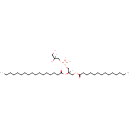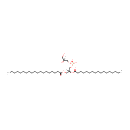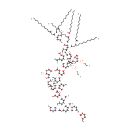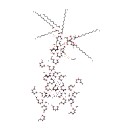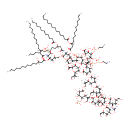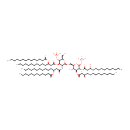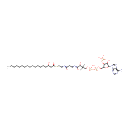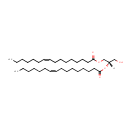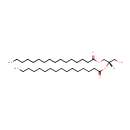
Search Results for compounds
Searching compounds for
returned 4373 results.
PG(17:0/14:0) (PAMDB001502)
IUPAC:
[(2S)-2,3-dihydroxypropoxy][(2R)-2-(heptadecanoyloxy)-3-(tetradecanoyloxy)propoxy]phosphinic acid
CAS: Not Available
Description: PG(17:0/14:0) is a phosphatidylglycerol. Phosphatidylglycerols consist of a glycerol 3-phosphate backbone esterified to either saturated or unsaturated fatty acids on carbons 1 and 2. As is the case with diacylglycerols, phosphatidylglycerols can have many different combinations of fatty acids of varying lengths and saturation attached to the C-1 and C-2 positions. PG(17:0/14:0), in particular, consists of one heptadecanoyl chain to the C-1 atom, and one tetradecanoyl to the C-2 atom. In Pseudomonas aeruginosa glycerophospholipid metabolism, phosphatidylglycerol is formed from phosphatidic acid (1,2-diacyl-sn-glycerol 3-phosphate) by a sequence of enzymatic reactions that proceeds via two intermediates, cytidine diphosphate diacylglycerol (CDP-diacylglycerol) and phosphatidylglycerophosphate (PGP, a phosphorylated phosphatidylglycerol). Phosphatidylglycerols, along with CDP-diacylglycerol, also serve as precursor molecules for the synthesis of cardiolipin, a phospholipid found in membranes.
PG(17:0/19:0) (PAMDB001503)
IUPAC:
[(2S)-2,3-dihydroxypropoxy][(2R)-2-(heptadecanoyloxy)-3-(nonadecanoyloxy)propoxy]phosphinic acid
CAS: Not Available
Description: PG(17:0/19:0) is a phosphatidylglycerol. Phosphatidylglycerols consist of a glycerol 3-phosphate backbone esterified to either saturated or unsaturated fatty acids on carbons 1 and 2. As is the case with diacylglycerols, phosphatidylglycerols can have many different combinations of fatty acids of varying lengths and saturation attached to the C-1 and C-2 positions. PG(17:0/19:0), in particular, consists of one heptadecanoyl chain to the C-1 atom, and one nonadecanoyl to the C-2 atom. In Pseudomonas aeruginosa glycerophospholipid metabolism, phosphatidylglycerol is formed from phosphatidic acid (1,2-diacyl-sn-glycerol 3-phosphate) by a sequence of enzymatic reactions that proceeds via two intermediates, cytidine diphosphate diacylglycerol (CDP-diacylglycerol) and phosphatidylglycerophosphate (PGP, a phosphorylated phosphatidylglycerol). Phosphatidylglycerols, along with CDP-diacylglycerol, also serve as precursor molecules for the synthesis of cardiolipin, a phospholipid found in membranes.
LPS (1-O-antigen) (PAMDB001504)
IUPAC:
(2R,3S,4R,5R,6R)-5-{[(3S,4R,5R,6R)-5-[({[(2-aminoethoxy)(hydroxy)phosphoryl]oxy}(hydroxy)phosphoryl)oxy]-4-{[(3S,4S,5R,6R)-4-{[(3R,4S,5R,6R)-4-{[(2R,3R,4S,5R,6R)-3-{[(3R,4S,5R,6R)-3-{[(2S,3R,4R,5S,6R)-4,5-dihydroxy-3-[(C-hydroxycarbonimidoyl)amino]-6-(hydroxymethyl)oxan-2-yl]oxy}-4-{[(2S,3R,4R,5R,6R)-6-({[(2R,3R,4R,5S,6R)-4,5-dihydroxy-3-[(C-hydroxycarbonimidoyl)amino]-6-(hydroxymethyl)oxan-2-yl]oxy}methyl)-5-hydroxy-4-{[(2R,3R,4R,5R,6R)-5-hydroxy-3-[(1-hydroxyethylidene)amino]-6-(hydroxymethyl)-4-{[(2S,3R,4S,5R,6R)-3,4,5-trihydroxy-6-({[(2S,3R,4S,5R,6R)-3,4,5-trihydroxy-6-(hydroxymethyl)oxan-2-yl]oxy}methyl)oxan-2-yl]oxy}oxan-2-yl]oxy}-3-[(1-hydroxyethylidene)amino]oxan-2-yl]oxy}-5-hydroxy-6-(hydroxymethyl)oxan-2-yl]oxy}-4,5-dihydroxy-6-(hydroxymethyl)oxan-2-yl]oxy}-3,5-dihydroxy-6-({[(2S,3R,4S,5R,6R)-3,4,5-trihydroxy-6-(hydroxymethyl)oxan-2-yl]oxy}methyl)oxan-2-yl]oxy}-6-[(2S)-1-{[(3S,4R,5S,6R)-3,4-dihydroxy-6-[(2S)-1-hydroxypropan-2-yl]-5-(phosphonooxy)oxan-2-yl]oxy}propan-2-yl]-3,5-dihydroxyoxan-2-yl]oxy}-3-hydroxy-6-[(2S)-1-hydroxypropan-2-yl]oxan-2-yl]oxy}-4-{[(2S,3S,4S,5R,6R)-4-{[(2S,3S,4S,5R,6R)-4-{[(2-aminoethoxy)(hydroxy)phosphoryl]oxy}-2-carboxy-3,5-dihydroxy-6-[(2S)-1-hydroxypropan-2-yl]oxan-2-yl]oxy}-2-carboxy-3,5-dihydroxy-6-[(2S)-1-hydroxypropan-2-yl]oxan-2-yl]oxy}-2-{[(2R,3S,4R,5R,6R)-6-{[(2R,3S,4R,5R,6R)-5-{[(3R)-1,3-dihydroxytetradecylidene]amino}-3-hydroxy-4-{[(3R)-3-hydroxytetradecanoyl]oxy}-6-(phosphonooxy)oxan-2-yl]methoxy}-5-{[(3R)-3-(dodecanoyloxy)-1-hydroxytetradecylidene]amino}-3-(phosphonooxy)-4-{[(3R)-3-(tetradecanoyloxy)tetradecanoyl]oxy}oxan-2-yl]methoxy}-3-hydroxy-6-[(2S)-1-hydroxypropan-2-yl]oxane-2-carboxylic acid
CAS: Not Available
Description: Lipopolysaccharides (LPS), also known as lipoglycans, are large molecules consisting of a lipid and a polysaccharide joined by a covalent bond; they are found in the outer membrane of Gram-negative bacteria, act as endotoxins and elicit strong immune responses in animals. LPS consists of three parts: O antigen (or O polysaccharide), core polysaccharide and lipid A.When LPS contains a repetitive glycan polymer this is referred to as the O antigen, O polysaccharide, or O side chain of the bacteria. LPS (1-o-antigen) contains only one unit of O antigen. The O antigen is attached to the core oligosaccharide, and comprises the outermost domain of the LPS molecule. The composition of the O chain varies from strain to strain, for example there are over 160 different O antigen structures produced by different Pseudomonas aeruginosa strains. The presence or absence of O chains determine whether the LPS is considered rough or smooth. Full length O-chains would render the LPS smooth while the absence or reduction of O-chains would make the LPS rough. Bacteria with rough LPS usually have more penetrable cell membranes to hydrophobic antibiotics since a rough LPS is more hydrophobic. O antigen is exposed on the very outer surface of the bacterial cell, and as a consequence, is a target for recognition by host antibodies.
LPS (4-O-antigen) (PAMDB001505)
IUPAC:
(2R,3S,4R,5R,6R)-5-{[(3S,4R,5R,6R)-5-[({[(2-aminoethoxy)(hydroxy)phosphoryl]oxy}(hydroxy)phosphoryl)oxy]-4-{[(3S,4S,5R,6R)-4-{[(3R,4S,5R,6R)-4-{[(2R,3R,4S,5R,6R)-3-{[(3R,4S,5R,6R)-3-{[(2S,3R,4R,5S,6R)-4,5-dihydroxy-3-[(C-hydroxycarbonimidoyl)amino]-6-(hydroxymethyl)oxan-2-yl]oxy}-4-{[(2S,3R,4R,5R,6R)-6-({[(2R,3R,4R,5S,6R)-4,5-dihydroxy-3-[(C-hydroxycarbonimidoyl)amino]-6-(hydroxymethyl)oxan-2-yl]oxy}methyl)-4-{[(2R,3R,4R,5R,6R)-4-{[(2S,3R,4S,5R,6R)-3-{[(2S,3R,4R,5R,6R)-6-({[(2R,3R,4R,5S,6R)-4,5-dihydroxy-3-[(C-hydroxycarbonimidoyl)amino]-6-(hydroxymethyl)oxan-2-yl]oxy}methyl)-4-{[(2R,3R,4R,5R,6R)-4-{[(2S,3R,4S,5R,6R)-3-{[(2S,3R,4R,5R,6R)-6-({[(2R,3R,4R,5S,6R)-4,5-dihydroxy-3-[(C-hydroxycarbonimidoyl)amino]-6-(hydroxymethyl)oxan-2-yl]oxy}methyl)-4-{[(2R,3R,4R,5R,6R)-4-{[(2S,3R,4S,5R,6R)-3-{[(2S,3R,4R,5R,6R)-6-({[(2R,3R,4R,5S,6R)-4,5-dihydroxy-3-[(C-hydroxycarbonimidoyl)amino]-6-(hydroxymethyl)oxan-2-yl]oxy}methyl)-5-hydroxy-4-{[(2R,3R,4R,5R,6R)-5-hydroxy-3-[(1-hydroxyethylidene)amino]-6-(hydroxymethyl)-4-{[(2S,3R,4S,5R,6R)-3,4,5-trihydroxy-6-({[(2S,3R,4S,5R,6R)-3,4,5-trihydroxy-6-(hydroxymethyl)oxan-2-yl]oxy}methyl)oxan-2-yl]oxy}oxan-2-yl]oxy}-3-[(1-hydroxyethylidene)amino]oxan-2-yl]oxy}-4,5-dihydroxy-6-({[(2S,3R,4S,5R,6R)-3,4,5-trihydroxy-6-(hydroxymethyl)oxan-2-yl]oxy}methyl)oxan-2-yl]oxy}-5-hydroxy-3-[(1-hydroxyethylidene)amino]-6-(hydroxymethyl)oxan-2-yl]oxy}-5-hydroxy-3-[(1-hydroxyethylidene)amino]oxan-2-yl]oxy}-4,5-dihydroxy-6-({[(2S,3R,4S,5R,6R)-3,4,5-trihydroxy-6-(hydroxymethyl)oxan-2-yl]oxy}methyl)oxan-2-yl]oxy}-5-hydroxy-3-[(1-hydroxyethylidene)amino]-6-(hydroxymethyl)oxan-2-yl]oxy}-5-hydroxy-3-[(1-hydroxyethylidene)amino]oxan-2-yl]oxy}-4,5-dihydroxy-6-({[(2S,3R,4S,5R,6R)-3,4,5-trihydroxy-6-(hydroxymethyl)oxan-2-yl]oxy}methyl)oxan-2-yl]oxy}-5-hydroxy-3-[(1-hydroxyethylidene)amino]-6-(hydroxymethyl)oxan-2-yl]oxy}-5-hydroxy-3-[(1-hydroxyethylidene)amino]oxan-2-yl]oxy}-5-hydroxy-6-(hydroxymethyl)oxan-2-yl]oxy}-4,5-dihydroxy-6-(hydroxymethyl)oxan-2-yl]oxy}-3,5-dihydroxy-6-({[(2S,3R,4S,5R,6R)-3,4,5-trihydroxy-6-(hydroxymethyl)oxan-2-yl]oxy}methyl)oxan-2-yl]oxy}-6-[(2S)-1-{[(3S,4R,5S,6R)-3,4-dihydroxy-6-[(2S)-1-hydroxypropan-2-yl]-5-(phosphonooxy)oxan-2-yl]oxy}propan-2-yl]-3,5-dihydroxyoxan-2-yl]oxy}-3-hydroxy-6-[(2S)-1-hydroxypropan-2-yl]oxan-2-yl]oxy}-4-{[(2S,3S,4S,5R,6R)-4-{[(2S,3S,4S,5R,6R)-4-{[(2-aminoethoxy)(hydroxy)phosphoryl]oxy}-2-carboxy-3,5-dihydroxy-6-[(2S)-1-hydroxypropan-2-yl]oxan-2-yl]oxy}-2-carboxy-3,5-dihydroxy-6-[(2S)-1-hydroxypropan-2-yl]oxan-2-yl]oxy}-2-{[(2R,3S,4R,5R,6R)-6-{[(2R,3S,4R,5R,6R)-5-{[(3R)-1,3-dihydroxytetradecylidene]amino}-3-hydroxy-4-{[(3R)-3-hydroxytetradecanoyl]oxy}-6-(phosphonooxy)oxan-2-yl]methoxy}-5-{[(3R)-3-(dodecanoyloxy)-1-hydroxytetradecylidene]amino}-3-(phosphonooxy)-4-{[(3R)-3-(tetradecanoyloxy)tetradecanoyl]oxy}oxan-2-yl]methoxy}-3-hydroxy-6-[(2S)-1-hydroxypropan-2-yl]oxane-2-carboxylic acid
CAS: Not Available
Description: Lipopolysaccharides (LPS), also known as lipoglycans, are large molecules consisting of a lipid and a polysaccharide joined by a covalent bond; they are found in the outer membrane of Gram-negative bacteria, act as endotoxins and elicit strong immune responses in animals. LPS consists of three parts: O antigen (or O polysaccharide), core polysaccharide and lipid A.When LPS contains a repetitive glycan polymer this is referred to as the O antigen, O polysaccharide, or O side chain of the bacteria. LPS (1-o-antigen) contains four units of O antigen. The O antigen is attached to the core oligosaccharide, and comprises the outermost domain of the LPS molecule. The composition of the O chain varies from strain to strain, for example there are over 160 different O antigen structures produced by different Pseudomonas aeruginosa strains. The presence or absence of O chains determine whether the LPS is considered rough or smooth. Full length O-chains would render the LPS smooth while the absence or reduction of O-chains would make the LPS rough. Bacteria with rough LPS usually have more penetrable cell membranes to hydrophobic antibiotics since a rough LPS is more hydrophobic. O antigen is exposed on the very outer surface of the bacterial cell, and as a consequence, is a target for recognition by host antibodies.
Ra-LPS (PAMDB001506)
IUPAC:
(2R,3S,4R,5R,6R)-5-{[(3S,4R,5R,6R)-5-[({[(2-aminoethoxy)(hydroxy)phosphoryl]oxy}(hydroxy)phosphoryl)oxy]-4-{[(3S,4S,5R,6R)-4-{[(3R,4S,5R,6R)-4-{[(2R,3R,4S,5R,6R)-3-{[(3R,4S,5S,6R)-3-{[(2S,3R,4R,5S,6R)-4,5-dihydroxy-3-[(C-hydroxycarbonimidoyl)amino]-6-(hydroxymethyl)oxan-2-yl]oxy}-4,5-dihydroxy-6-(hydroxymethyl)oxan-2-yl]oxy}-4,5-dihydroxy-6-(hydroxymethyl)oxan-2-yl]oxy}-3,5-dihydroxy-6-({[(2S,3R,4S,5R,6R)-3,4,5-trihydroxy-6-(hydroxymethyl)oxan-2-yl]oxy}methyl)oxan-2-yl]oxy}-6-[(2S)-1-{[(3S,4R,5S,6R)-3,4-dihydroxy-6-[(2S)-1-hydroxypropan-2-yl]-5-(phosphonooxy)oxan-2-yl]oxy}propan-2-yl]-3,5-dihydroxyoxan-2-yl]oxy}-3-hydroxy-6-[(2S)-1-hydroxypropan-2-yl]oxan-2-yl]oxy}-4-{[(2S,3S,4S,5R,6R)-4-{[(2S,3S,4S,5R,6R)-4-{[(2-aminoethoxy)(hydroxy)phosphoryl]oxy}-2-carboxy-3,5-dihydroxy-6-[(2S)-1-hydroxypropan-2-yl]oxan-2-yl]oxy}-2-carboxy-3,5-dihydroxy-6-[(2S)-1-hydroxypropan-2-yl]oxan-2-yl]oxy}-2-{[(2R,3S,4R,5R,6R)-6-{[(2R,3S,4R,5R,6R)-5-{[(3R)-1,3-dihydroxytetradecylidene]amino}-3-hydroxy-4-{[(3R)-3-hydroxytetradecanoyl]oxy}-6-(phosphonooxy)oxan-2-yl]methoxy}-5-{[(3R)-3-(dodecanoyloxy)-1-hydroxytetradecylidene]amino}-3-(phosphonooxy)-4-{[(3R)-3-(tetradecanoyloxy)tetradecanoyl]oxy}oxan-2-yl]methoxy}-3-hydroxy-6-[(2S)-1-hydroxypropan-2-yl]oxane-2-carboxylic acid
CAS: Not Available
Description: Lipopolysaccharides (LPS), also known as lipoglycans, are large molecules consisting of a lipid and a polysaccharide joined by a covalent bond; they are found in the outer membrane of Gram-negative bacteria, act as endotoxins and elicit strong immune responses in animals. There are 2 forms of LPS: smooth-form and rough-form. The smooth-form (S-form) LPS consists of three parts: O antigen (or O polysaccharide), core region and lipid A. The rough-form (R-form) LPS only consists of core region and lipid A. The Core domain always contains an oligosaccharide component which attaches directly to lipid A and commonly contains sugars such as heptose and 3-deoxy-D-mannooctulosonic acid (also known as KDO, keto-deoxyoctulosonate). Depending on the quantity and composition of the sugars in the core region, Pseudomonas aeruginosa K-12 R-form LPS can be classified as Ra, Rb1, Rb2, Rc, Rd1, Rd2, and Re-LPS. LPS is first synthesized as KDO-lipid A or Re-LPS. Adding more sugars to the core region gives rise to Rd, Rc, Rb and Ra-LPS. (Wikipedia; PMID: 17403049; PMID: 17364071; PMDI: 20203010)
Lipid A (PAMDB001507)
IUPAC:
{[(2R,3S,4R,5R,6R)-5-[(3R)-3-(dodecanoyloxy)tetradecanamido]-6-{[(2R,3S,4R,5R,6R)-3-hydroxy-5-[(3R)-3-hydroxytetradecanamido]-4-{[(3R)-3-hydroxytetradecanoyl]oxy}-6-(phosphonooxy)oxan-2-yl]methoxy}-2-(hydroxymethyl)-4-{[(3R)-3-(tetradecanoyloxy)tetradecanoyl]oxy}oxan-3-yl]oxy}phosphonic acid
CAS: Not Available
Description: Lipid A is a lipid that comprises the innermost of the three regions of the lipopolysaccharide (LPS) molecule found in the outer membrane of Gram-negative bacteria such as Pseudomonas aeruginosa. Its hydrophobic nature allows it to anchor the LPS to the outer membrane. Lipid A consists of two glucosamine (carbohydrate/sugar) units with attached acyl chains ("fatty acids"), and normally containing one phosphate group on each carbohydrate. The Pseudomonas aeruginosa lipid A typically has four C14 hydroxy acyl chains attached to the sugars and one C14 and one C12 attached to the beta hydroxy groups. (Wikipedia)
(S)-3-Hydroxyoctadecanoyl-CoA (PAMDB001510)
IUPAC:
4-({[({[5-(6-amino-9H-purin-9-yl)-4-hydroxy-3-(phosphonooxy)oxolan-2-yl]methoxy}(hydroxy)phosphoryl)oxy](hydroxy)phosphoryl}oxy)-2-hydroxy-N-[2-({2-[(3-hydroxyoctadecanoyl)sulfanyl]ethyl}-C-hydroxycarbonimidoyl)ethyl]-3,3-dimethylbutanimidic acid
CAS: Not Available
Description: (s)-3-hydroxyoctadecanoyl-coa belongs to the class of Acyl CoAs. These are organic compounds contaning a coenzyme A substructure linked to another moeity through an ester bond. (inferred from compound structure)
1,2-Diacyl-sn-glycerol (didodecanoyl, n-C12:0) (PAMDB001512)
IUPAC:
(2S)-1-(dodecanoyloxy)-3-hydroxypropan-2-yl dodecanoate
CAS: Not Available
Description: 1,2-diacyl-sn-glycerol (didodecanoyl, n-c12:0) belongs to the class of Diacylglycerols. These are glycerides consisting of two fatty acid chains covalently bonded to a glycerol molecule through ester linkages. (inferred from compound structure)
1,2-Diacyl-sn-glycerol (dihexadec-9-enoyl, n-C16:1) (PAMDB001513)
IUPAC:
(2S)-1-[(9Z)-hexadec-9-enoyloxy]-3-hydroxypropan-2-yl (9Z)-hexadec-9-enoate
CAS: Not Available
Description: 1,2-diacyl-sn-glycerol (dihexadec-9-enoyl, n-c16:1) belongs to the class of Diacylglycerols. These are glycerides consisting of two fatty acid chains covalently bonded to a glycerol molecule through ester linkages. (inferred from compound structure)
1,2-Diacyl-sn-glycerol (dihexadecanoyl, n-C16:0) (PAMDB001514)
IUPAC:
(2S)-1-(hexadecanoyloxy)-3-hydroxypropan-2-yl hexadecanoate
CAS: Not Available
Description: 1,2-diacyl-sn-glycerol (dihexadecanoyl, n-c16:0) belongs to the class of Diacylglycerols. These are glycerides consisting of two fatty acid chains covalently bonded to a glycerol molecule through ester linkages. (inferred from compound structure)
